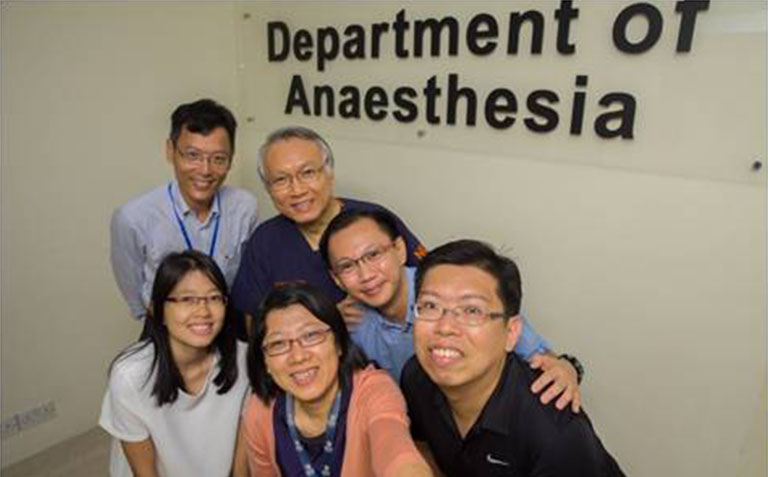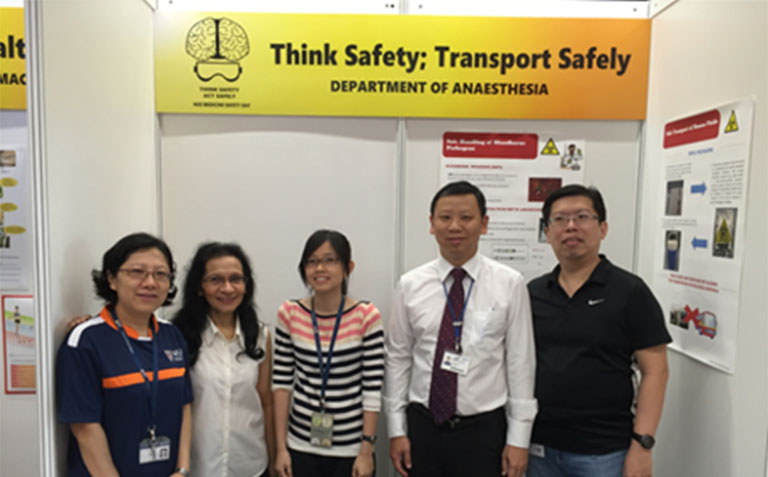About Our Research

Prof Lee Tat Leang, A/Prof Eugene Liu and A/Prof Low Chian Ming with the research team members

A/Prof Ti Lian Kah with research team at NUS Medicine Safety Day
The Research Laboratory of the Department of Anaesthesia, The National University of Singapore is supervised by Professor Lee Tat Leang and Associate Professor Low Chiang Ming, and headed by Associate Professor Ti Lian Kah.
Demands from a rapidly expanding clinical service resulted in several years of anaemic research output. However, from 2014, NUS Anaesthesia has made significant progress in both the quantity and quality of research output. In 2016, the Department published 21 papers, twice the average annual output from 2009-2013. More significantly, the quality of research improved in tandem, with the average impact factor of the journals in which our papers were published in increasing from 1.18 in 2012 to 1.96 in 2016. This was made possible by investments in both support personnel and infrastructure, and by actively seeking collaborations with other departments, specialties, hospitals and internationally. Going forward, the Department intends to focus its research in these areas.
A. Improving Patient Outcomes
Undergoing surgery, particularly major surgery, is very stressful to the patient, and is an expensive modality of treatment. While patients hope to have full functional recovery, complications both minor and major are not uncommon, and may result in long-term morbidity and socio-economic costs. Important perioperative complications include myocardial infarction, stroke, acute kidney injury, delirium, persistent pain, and atrial fibrillation. Our research has shown that our Asian patients are different from Western populations in terms of the incidence, risk factors, and sequelae of these complications. This may be due to differences in co-morbidities such as the high prevalence of diabetes in our population, or genetic differences. Therefore, adoption of clinical pathways based on Caucasian populations may not be ideal for our population. We intend to prospectively confirm our findings, elucidate the mechanistic pathways that are relevant to our population, and introduce clinical pathways that are best suited for our population with particular emphasis on modifiable risk factors.
B. Pain
Led by Professor Lee Tat Leang and Associate Professor Low Chian Ming, and supported by Dr Francis Tan (Sr Research Fellow); Dr Li Chunmei (Sr Laboratory Executive) and Ms Liu Weiling (MSc Candidate), our laboratory has developed robust murine pain models, and is currently investigating novel neuropeptides that are expressed in the cerebral spinal fluid in chronic pain.
C. Medical Education
The Department has published papers and won grants for research into teaching pedagogy, particularly with the use of simulation. Currently, the Department is looking into better ways to teach the clinical skill of endotracheal intubation, a skill that is known to be notoriously difficult to learn and retain.
D. Mentorship
Guiding junior faculty, residents and medical students through research projects is a mutually beneficial aim of NUS Anaesthesia. Junior researchers get a chance to present their work in a conference and hopefully to publish their work. Inculcating a community of young researchers is a major aim of the Department. In 2016, one resident and two medical students won awards at conferences in the United Kingdom and the United States for their poster presentations of research performed under the supervision of their mentors, Dr Sophia Chew and Assoc Prof Ti Lian Kah.

